Sun activity for October 31, 2023: Watch a promising sunspot group grow
Sunspot group AR3474 has grown over the past several days and is now larger than Earth, sitting near the solar disk’s center. This is a great location to throw coronal mass ejections (CMEs) our way, which could then bring geomagnetic storms and auroras! The region showed an increase in flaring after developing a small delta region (meaning it has the potential to produce powerful flares), although it has since lost this region and returned to a minor magnetic complexity. AR3474 is one of just three regions currently on the solar disk, but there may be another one in view soon. A region continues to shoot out jets of plasma just over the eastern limb (edge), so the sun’s rotation should soon bring it onto the Earth-viewed side of our star.
Last 24 hours: Sun activity is low, with six C flares during the past day. AR3473 and AR3474 produced all the flares, with AR3474 producing the most. The largest event was a C5.7 flare from AR3474 at 00:10 UTC on October 31. We also observed a nice plasma jet in the west, and at the north pole a huge prominence lifted away from the solar surface and headed northward.
Sun activity for October 30, 2023: AR3474 flaring and new backside region
While still low, sun activity has increased closer to the M flare level. Sunspot region AR3474 developed a small delta region, a sign of the potential for intense flares. This is in line with the overall increase in activity from the region. AR3474 produced all the flares of the past day. And, along with its increase in magnetic complexity, AR3474 has grown in size. Meanwhile, sunspot region AR3473 has also had a slight increase in size and complexity, but not to the level of AR3474. We are seeing jets from just around the sun’s eastern limb just south of the equator. Looking at backside images – using helioseismology – the source region is visible and should be rotating into view in about one to two days. Overall, the increase with AR3474 and this new region might bode well for increasing flaring, bringing the overall lull in activity in recent days to and end. Stay tuned to see if we have some M flares or beyond.
Last 24 hours: Sun activity is low, with only C and B flares during the past day. AR3474 was the sole flare producer. We observed four C flares and one B-class flare. The largest event was a C7.9 flare (from AR3474) at 13 UTC on October 29. The sun has four Earth-facing regions.
Sun activity for October 29, 2023: Solar wind here, G1 storming and auroras
Aurora alert! The expected fast solar wind from the coronal hole we’ve been watching is here. And that means auroras are here, too. Earth’s magnetic field reached G1 (minor) storm levels overnight, and that level of activity is expected to continue throughout the day today. As more of the fast solar wind reaches us, the storming should continue and perhaps increase to G2 (moderate) levels. This would mean more exciting auroral displays. Some examples have begun to be shared on social media. See the image below. Clear skies and good luck to all aurora watchers!
Last 24 hours: Sun activity is back to a low-level flaring activity, with only C and B flares during the past day. We observed five C flares and two B-class flares during the period. The largest event was a C2.6 flare from AR3473 at 9:47 UTC on October 29. AR3473 was the lead flare producer. It produced seven of the day’s flares. In addition to the coronal hole and these small flares, the sun is covered with filaments. Perhaps some of these will erupt. The sun has four Earth-facing regions.
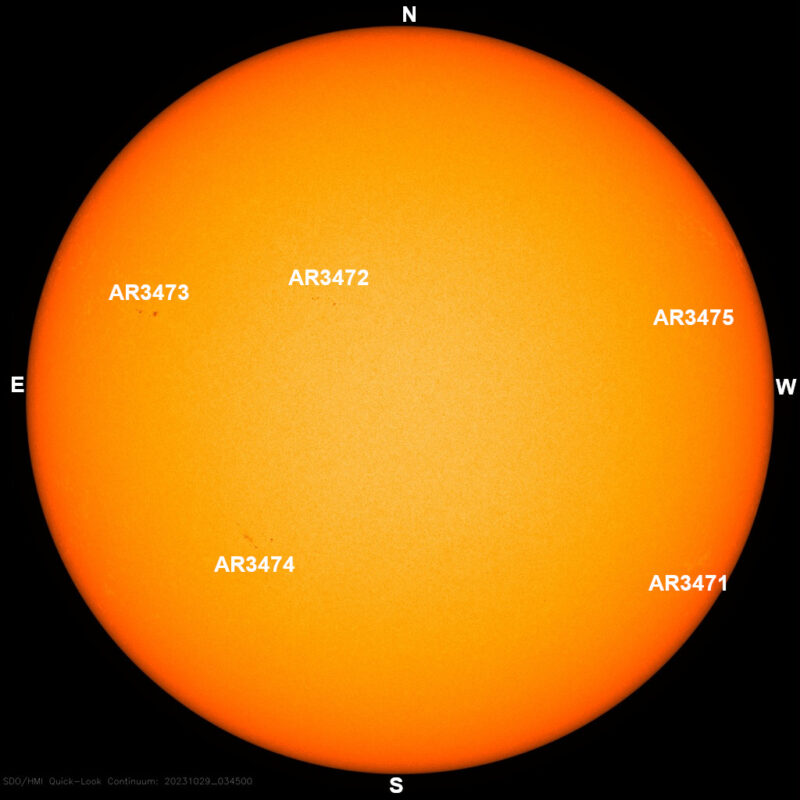
Sun activity for October 28, 2023: Prominences, filaments, and a big coronal hole
Sun activity is back to a low level with only C and B flares. Our attention is now focused on prominences, filaments, and a big coronal hole. A prominence at the south pole is entertaining us with its magnetic dance. The filaments around the area that produced yesterday’s M1.4 flare are active. There is some low level flaring and potential for more spectacular eruptions similar to yesterday’s. Lastly, the transequatorial coronal hole, which formed from two coronal holes merging, has sent its fast solar wind our way down the sun-Earth magnetic highway. The stream is expected to reach us on October 30, 2023, bringing the possibility of G1 (minor) and maybe even G2 (moderate) level storms. And that means a chance for some great auroral displays at higher latitudes. Good luck, aurora chasers!
Last 24 hours: Sun activity is low with the production of only C and B flares during the past day. We observed four C flares and two B-class flares during the period. The largest event was a C1.7 flare from AR3473 at 6:26 UTC on October 28. AR3473 was the lead flare producer. It produced four of the day’s flares. AR3474 is a newly numbered region. The sun has four Earth-facing regions. The now transequatorial coronal hole near the solar disk’s center continues moving into a geoeffective position. This means that the fast solar wind released by the hole should be reaching Earth in the next couple of days. We are expecting some possible G1 (minor) geomagnetic storming with a chance for G2 (moderate) storming by October 30.
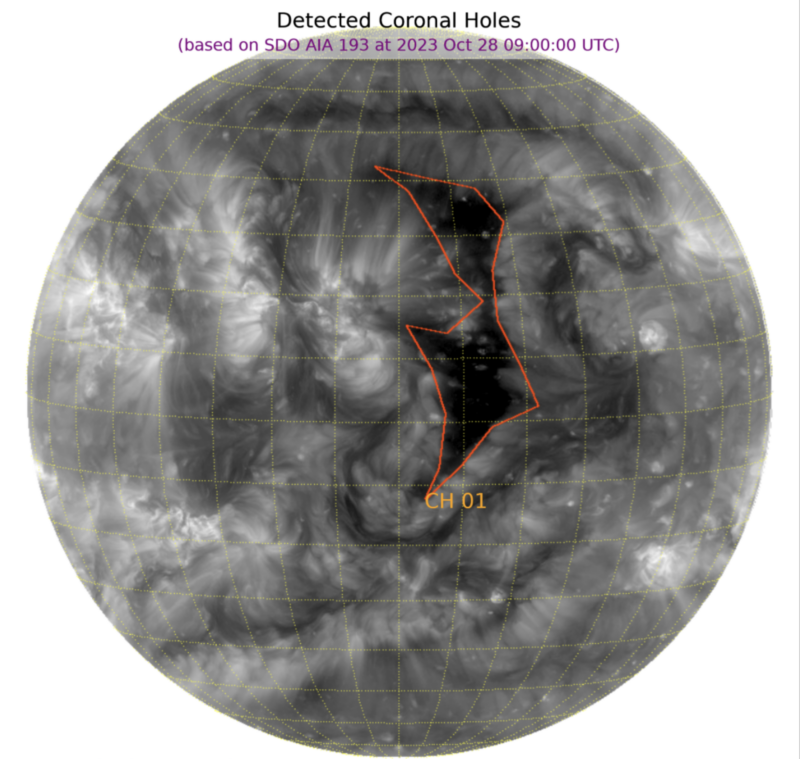
Sun activity for October 27, 2023: M flare! Activity kicks up a notch
After a lull lasting weeks, sun activity has now risen to moderate! This rise came after a large filament – a rope of solar material and magnetic fields – curled over the sun’s eastern limb (edge) and lifted off the sun in a beautiful eruption. As the plasma rose up into the solar atmosphere, it pulled the magnetic fields with it. These fields then snapped back, releasing a huge amount of energy in the form of a long-duration M1.4 solar flare. This fantastic eruption released a coronal mass ejection (CME) which sped off to the east of the sun (away from Earth). Does this mark the end of the recent lull in solar activity? We can only hope!
Last 24 hours: Sun activity is moderate. The sun produced nine flares during the past day: eight C flares and one M-class flare. The largest event was an M1.4 flare from AR3473 at 22:47 UTC on October 26. We have two newly numbered regions, AR3472 and AR3473, for a total of four regions facing Earth. The two large coronal holes near the solar disk’s center have merged into one large coronal hole spanning across the solar equator, which is now moving close to a geoeffective position. This means that the fast solar wind released by the hole should be reaching Earth in about three days. So we are expecting some possible G1 (minor) geomagnetic storming by October 30.
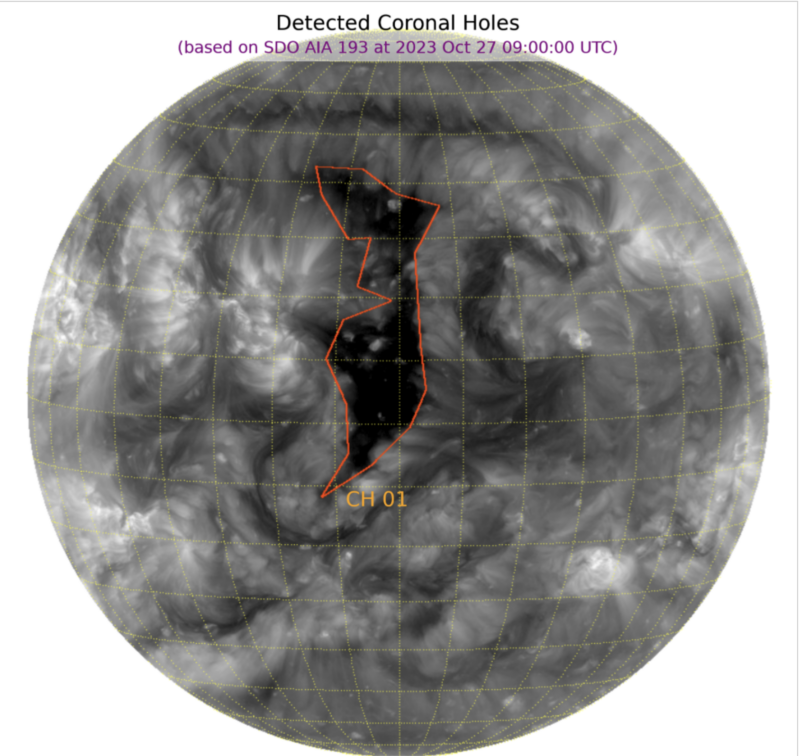
Sun activity for October 26, 2023 is rising. A prominence dances at the pole
Sun activity is still low. But the slight increase in activity continues. It seems the sun has taken a few days off, on its way to maximum in this Solar Cycle 25. October could be the low point in flaring for this year. Meanwhile, during the past day (11 UTC yesterday to 11 UTC today), we saw an active prominence dancing at the sun’s north pole. It was a lovely distraction in an otherwise calm day. The two large coronal holes we’ve been watching will soon move into a geoeffective position, where they will be capable of sending their fast solar wind Earth’s way, hopefully causing some auroral action. And here’s something fun! Mars has just entered in the field of view of the LASCO C3 imager – on the SOHO spacecraft – as Mercury is moving out. Mars and Mercury will have a conjunction in the next coming days, as seen by SOHO’s coronagraphs. Stay with us.
Last 24 hours: Sun activity is low. The sun produced 13 flares during the past day: eight C and five B-class flares. The largest event was a C3.0 flare from an unlabeled region (near AR3471) in the southwest at 22:44 UTC on October 25. This unnumbered region near AR3471 was the most active with five flares. The sun currently has two simple active regions on its Earth-facing side.
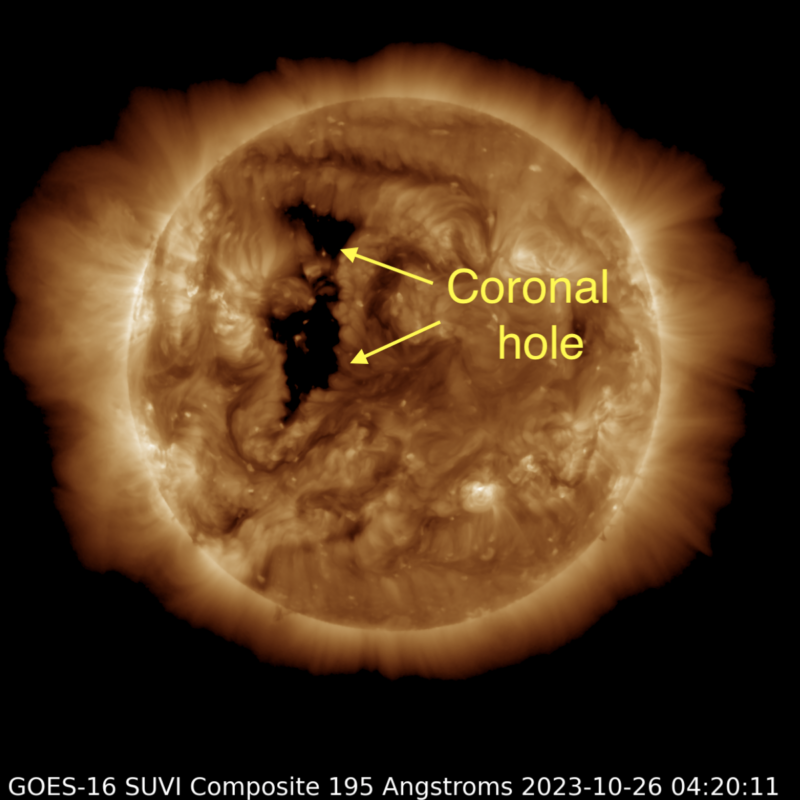
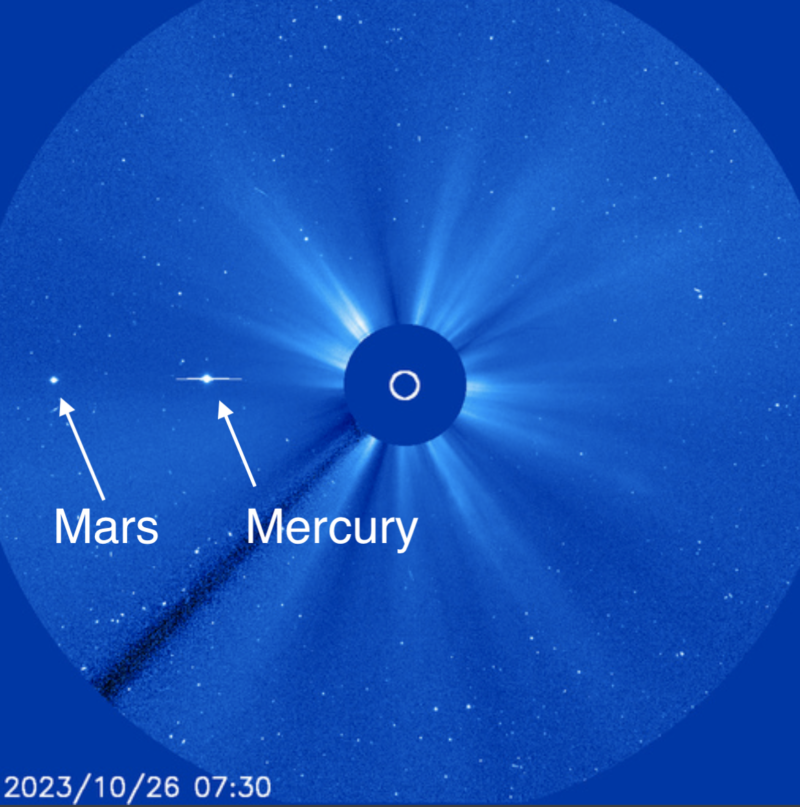
Sun activity for October 25, 2023. New regions ending the solar lull?
The end of the recent solar lull could be in sight! We’ve observed large coronal loops on the sun’s eastern limb (edge), as well as many small flares – twelve of today’s fourteen flares came from the solar horizon. That means that some new sunspot regions could be waiting to rotate into view. And looking at the far side of the sun using helioseismology, we can see several potential regions of interest. So is the lull ending? Stay tuned!
Last 24 hours: Sun activity is low, up from very low yesterday. The activity level has increased thanks to activity on the sun’s limb (edge) from unlabeled regions in the north and southeast. The sun produced fourteen flares during the past day (11 UTC yesterday to 11 UTC today): ten C and four B-class flares. The largest event was a C4.2 from an unlabeled sunspot region on the northeast at 23:59 UTC on October 24. The sun currently has three simple active regions on its Earth-facing side.
Sun activity for October 24, 2023. Prominences all around
The sun is still in its eerie lull. Over the past few days, it’s reached one of its least active points observed in the past year. The sun fired off only two flares in the past day. Yet we know the sun is marching on toward the peak in its 11-year solar cycle, due in the mid-2020s. There are signs of an active sun in the form of prominences – great ropes of solar material and magnetic fields – arcing up from around the solar limb (edge) in the past day. The third small prominence we reported on yesterday expanded to become a massive rope hanging off the sun. And the first two of yesterday’s prominences have fired out solar material in beautiful coronal mass ejections (CMEs), which were captured by the instruments aboard the SOHO spacecraft (see the imagery below). Neither CME was directed towards Earth.
Last 24 hours: Sun activity is very low. The sun produced just two flares during the past day (11 UTC yesterday to 11 UTC today): one C and one B-class flare. The largest event was a C2.3 from an unnumbered active region on the southwest at 19:58 UTC on October 23. The sun currently has only three simple active regions on its Earth-facing side. A pair of new coronal holes on the northeast will soon be located in a geoeffective position. Then, the fast solar wind they produce will be heading towards Earth’s magnetic field, providing opportunities for auroral displays by the end of this week.
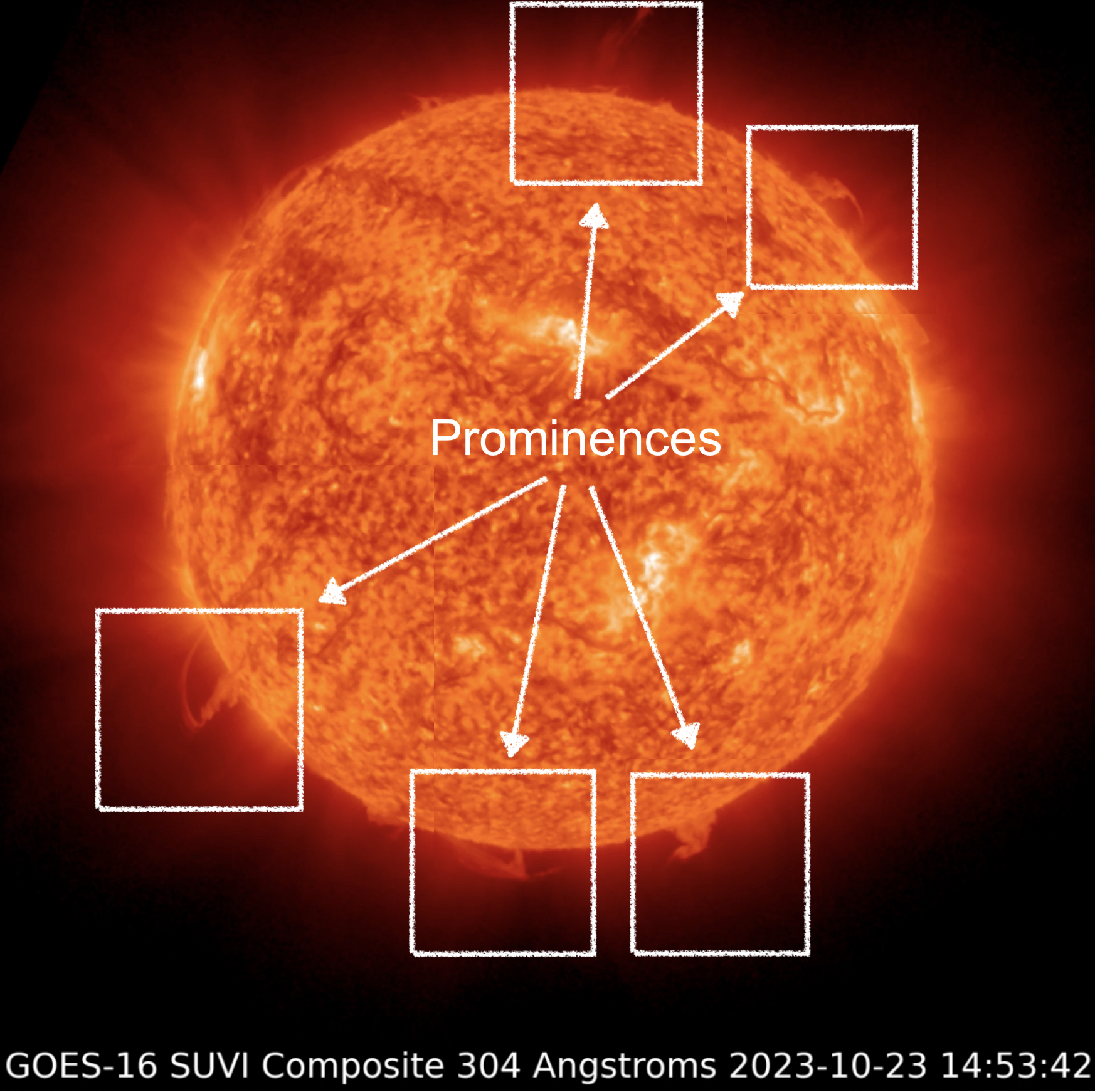
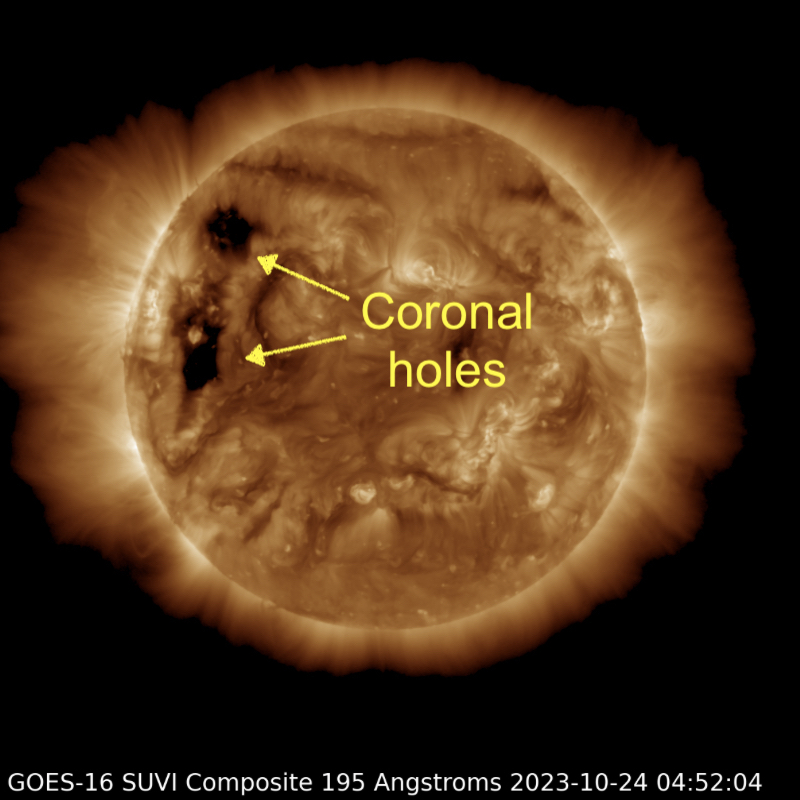
Sun activity for October 23, 2023. Three prominences a charm
We have an even quieter day on the sun than yesterday. Almost no flares and tiny boring sunspots. But wait there’s more! Prominences. Count them, not one or two but three rising off the sun in succession. The first one is noticeable around 21:00 UTC on October 22 off the northern limb (edge). Then look to the south at 23:28 UTC. These two are huge and quickly extend well beyond the large field-of-view of the GOES-16 SUVI instrument’s 304 angstrom wavelength channel. Then lastly a much smaller and narrowing prominence lifts off the western limb starting around 9:28 UTC on October 23. What a show. Those first two prominences extend of almost the diameter of the sun before disconnecting into space. That is an astonishing 865,000 miles or 1.4 million km. Even the little one at the end is more than 100,000 km long or about eight Earth’s before it has finished rising away from the solar surface. Those are some huge pieces of solar plasma. Thanks to the GOES SUVI instrument we are able to capture a good portion of these behemoths. We have also used a negative image combined with an SDO 171 angstrom wavelength image to better see the structures. Activity from the coronal mass ejection glancing blow at Earth has subsided though we may see some pick up due to high-speed solar wind from a coronal hole over the next day. Stay tuned as we wait to see when the flaring and Earth-directed eruptions will pick up.
Last 24 hours: Sun activity is very low. It is another quiet day at the sun. During the past day (11 UTC yesterday to 11 UTC today), the sun produced one C and one B class flare. Also, the probability of a C flare dropped to a new low of only 25%. That is a serious flare snooze fest. The largest flare was a C1.5 flare from active region AR3468 in the northwest at 6:58 UTC on October 23. The sun currently has four simple active regions on its Earth-facing side. Helioseismology is showing two possible new regions but they are 4 days away and nothing to write home about.
Sun activity for October 22, 2023. Time for a cap nap
Looking at today’s sun, you wouldn’t think solar maximum is so near at hand. But it is; it’s due in the mid-2020s. Over the past day, we saw only three flares, four small active regions, and no filament eruptions on the Earth-facing side. And yet – if you look more closely at the sun – the signs of its impending maximum are there. Observing the sun in white light, magnetic field, 304 angstroms and 171 angstrom wavelengths (see the image above), the active sun is more apparent. Notice: even though the sunspot regions are small, there are multiple regions. And: looking at the sun’s magnetic field, we see a lot of concentrated magnetic field activity. Finally: looking at the 304- and 171-angstrom wavelength channels, these areas of concentrated magnetic fields show up as bright patches. We can see giant loops on the east and west limbs (edges) in the 171-angstrom wavelength bands. The true quiet sun would not have these features. So we know the current calm is a calm before a storm. Activity will pick up. The climb toward solar maximum will continue!
Last 24 hours: Sun activity is low to very low. During the past day (11 UTC yesterday to 11 UTC today), the sun produced one C and two B class flares. The largest was a C1.5 flare from active region AR3464 in the northwest at 12:02 UTC on October 21. This active region produced the three flares. The sun currently has five simple active regions on its Earth-facing side.

Sun activity for October 21, 2023. Eruptions on sun, storming on Earth
The sun continues its relatively calm state, although there was a nice filament eruption on the northwest disk and a prominence liftoff from the southwest limb (edge), as shown in the image above. Meanwhile … exciting news! At the time of this writing, a G1 (minor) geomagnetic storm is ongoing. It’s bringing auroras this morning to Earth’s higher latitudes, in areas like Montana and North Dakota in the U.S. The threshold for the storm was reached at 8 UTC on October 21, 2023. Earth’s geomagnetic field is reported as disturbed in Ny-Ålesund and Tromsø in Norway. These are the effects of the coronal mass ejections (CMEs) hurled by the sun on October 17 and 18. The geomagnetic storming might continue for the rest of today, sparking auroras at high latitudes around the globe. Alert for aurora chasers! Get your cameras out, capture your beautiful photos, and, if you will, please share them with the EarthSky Community!
Last 24 hours: Sun activity is low to very low. In fact, NOAA has issued a notice for low-level sun activity over the next couple of days. During the past day (11 UTC yesterday to 11 UTC today), the sun produced three C and seven B class flares. The largest was a C2.8 flare from active region AR3467 in the northwest at 0:30 UTC on October 21. This active region was the main flare producer of the day with two Cs and two Bs. The sun currently has four simple active regions on its Earth-facing side. The newcomer that emerged in the northwest is labeled AR3469.
Sun activity for October 20, 2023. A fast filament eruption
We saw a big filament erupt in the southeast yesterday. It occurred near active region AR3468 at around 17:48 UTC. The prominence didn’t stay around long, but it provided a great show. Even with just 3 active regions currently on the Earth-viewed side of the sun, our star never seems to stop providing excitement!
Last 24 hours: Sun activity is at low to very low levels, producing only C and B class flares. Between 11 UTC yesterday and 11 UTC today we observed 12 flares: seven Cs and six Bs. The largest was a C2.7 flare by an unnumbered region in the northwest at 14:00 UTC on October 19. This active region has been sending ejecta into space with small flares, and is today’s lead flare producer with 6 of the 12 total flares. The sun currently has just 3 active regions on its Earth-viewed side.
Sun activity for October 19, 2023. A beautiful lightbulb-shaped CME
We saw a beautiful filament eruption from the sun’s far side that occurred at 2:48 UTC on October 18, 2023. It happened off the sun’s northwest limb (edge). This was a classic lightbulb-shaped coronal mass ejection (CME), an explosion of solar material and magnetic fields from the sun’s corona, or outer atmosphere. The LASCO C2 and C3 coronographs on the SOHO spacecraft picked it up. We see these iconic lightbulb shapes only from a particular vantage point in space (in this case, from SOHO). The CME expands out with a curved front. And – at its heart – we see a bright core, really, the explosion itself at its most intense, mimicking the lightbulb’s bright filament. If this CME had been Earth-directed, it might have produced some interesting effects at Earth. But it wasn’t Earth-directed (far side explosion, remember?). Still … lots of fun to see!
Last 24 hours: Sun activity remains at low, almost very low levels. Region AR3460 has decayed now. So, between 11 UTC yesterday and 11 UTC today, we saw only three, very simple active regions on the visible face of the sun. There were four C flares and two B flares. The largest flare was a C1.7 at 10 UTC on October 19 from region AR3462 on the northwest.
Sun activity for October 18, 2023. Double prominence action
We saw some double prominence action today. A large filament lifted off from the eastern limb (edge), creating a great prominence that rose to a height of more than 350,000 km before lifting off into space. At approximately the same time, a much smaller prominence (around 90,000 km above the solar surface) danced on the western limb, although this structure stayed tied to the sun.
Last 24 hours: Sun activity remains at low levels. Between 11 UTC yesterday and 11 UTC today, four C flares and eight B flares were produced. The largest flare was a C1.6, fired at 2:12 UTC on October 18 from an unnumbered active region on the northwest limb (edge). The lead flare producer honors go to AR3460, which produced four flares. Sunspot AR3465 is the largest on the solar face. It can be seen from the ground without any magnification, as long as you use the proper eye protection – wear eclipse or solar viewing glasses all the time you watch the sun. The sun currently has only three labeled active regions on its Earth-facing side. There is a new coronal hole in the northeast quadrant.

Sun activity for October 17, 2023. Something interesting this way comes
Solar action is returning in the northeast. First, we saw a C7.5 flare from sunspot region AR3467 at 11:10 UTC on October 16. This flare was associated with a fast filament eruption. Later, a C9.9 flare was blasted at 16:06 UTC by an as-yet-unnumbered active region incoming on the northeast limb (edge). This C9.9 flare was actually almost certainly an M flare, since it occurred beyond the solar horizon and so was partially blocked by the sun. Will these two sunspots be the next showstopping active regions? We’ll keep watching. Switching our attention to the viewpoint of the SOHO spacecraft, the brilliant visitors Mercury and Spica are close to almost simultaneous conjunctions with the sun. Take a look at the imagery below; of the two bright spots drawing closer to the sun, bright star Spica is on the left and planet Mercury is on the right.
Last 24 hours: Sun activity is low, with only C flares produced during the past day (11 UTC yesterday to 11 UTC today). The largest flare was a C9.9 fired on the northeast limb (edge) by an unnumbered incoming active region. The blast occurred at 16:06 UTC on October 16. The lead flare producer of the period was sunspot AR3463 with four flares. The sun currently has six labeled active regions on its Earth-facing side. There is a newcomer on the southeast now labeled AR3468.
Sun activity for October 16, 2023. Monday blues? Sun still on break
The fun eclipse weekend is over for most of us. But the sun is still taking a bit of a break. All of the current sunspot regions are small in size and magnetically simple. Sun activity remains low, with a trickle of solar flares. But don’t tell the filaments that. They remain active with a nice eruption off the sun’s southeast limb. Looking at SDO and GOES-16 SUVI 304-angstrom images side-by-side not only shows off the beautiful eruption, but is a great comparison and contrast of the capabilities of two space-based, sun-observing instruments. The SDO images provide more detail. But the SUVI images have a larger field-of-view, allowing us the see more of the eruption out into space. Great example of teamwork between complimentary spacecraft! Don’t forget to check out community eclipse pictures from Saturday. And stay tuned. Maybe this calm sun is a calm before a storm?
Last 24 hours: Sun activity is low, with only five C flares. During the past day (11 UTC yesterday to 11 UTC today), the largest flare was a C3.9 flare from active region AR3464 at 16:22 UTC on October 15, 2023. A new unnumbered region over the northeast limb (edge) was the most productive region with three of the five flares. The sun has six active labeled regions on its Earth-facing side.
Sun activity for October 15, 2023. Cool! Yesterday’s eclipse seen from space
Wow! What an exciting day yesterday was for the Americas! Most were able to experience at least some part of an annular solar eclipse. Even the GOES-16 spacecraft experienced a partial eclipse. Did you see the eclipse in the sky, or maybe online? Best photos here. Some of you might have seen small dark specs on the sun. Those were sunspots, probably AR3464 and/or AR3465. The regions are not large. But both have area close to that of Earth. You probably only saw them if you had solar binoculars or a telescope with a solar filter. You might also have seen them if you were using a projection method. If you saw them with your solar/eclipse glasses, then go you! You must have great vision. Don’t forget … you can use your solar/eclipse glasses to view the sun anytime. And, as we get closer to solar maximum in the mid-2020s, there will be more and larger sunspots. If you don’t have solar/eclipse glasses you can find them at the Earthsky store to use any day and to have for the April 8, 2024 total solar eclipse. Did you photograph the eclipse? If so, please consider sharing your photos on our community photo page. Today – one day after the eclipse – is a good day to relax … just like our star with its low sun activity. Happy sun day! Stay tuned for more sun news.
Last 24 hours: Sun activity is low, with only four C flares. During the past day (11 UTC yesterday to 11 UTC today), the largest flare was a C3.5 flare from active region AR3467 at 15:43 UTC on October 14, 2023. The region was the most productive region with three of the four flares. The sun has six active labeled regions on its Earth-facing side.
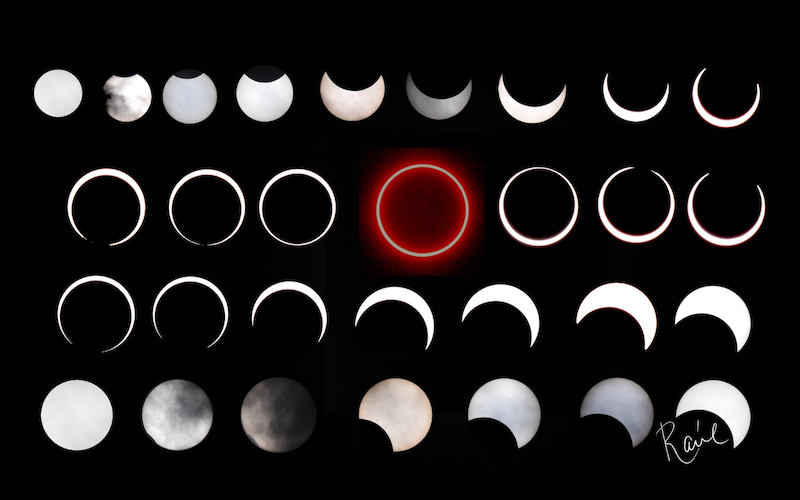
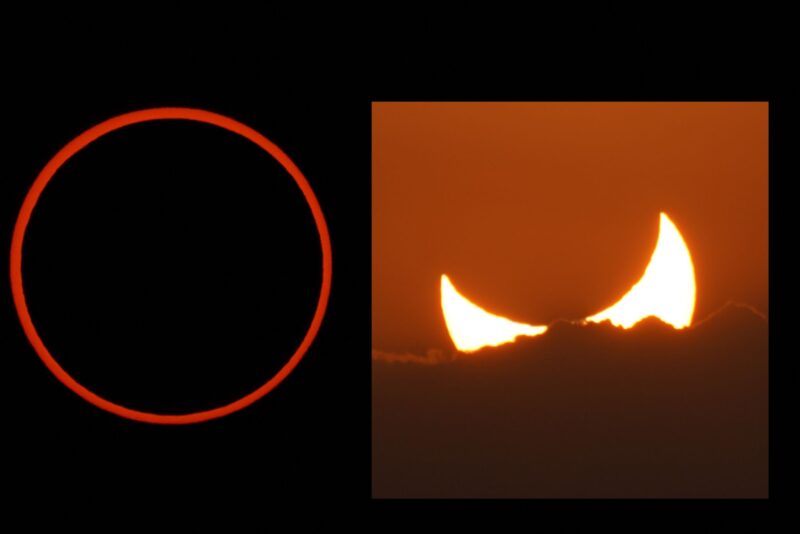
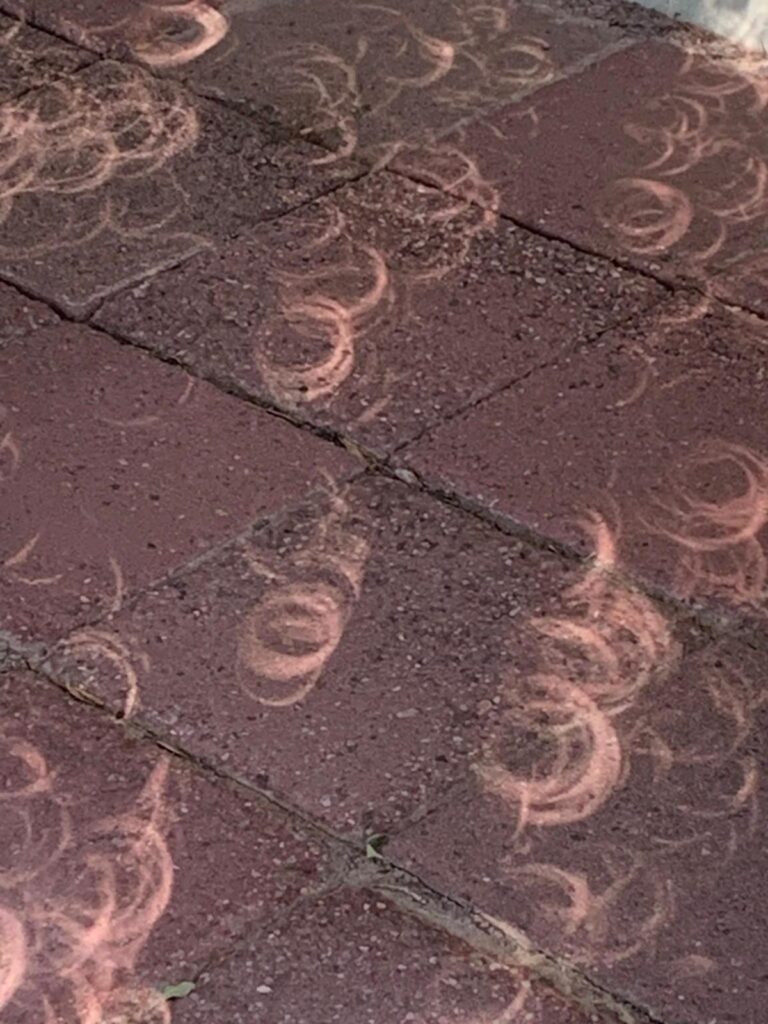
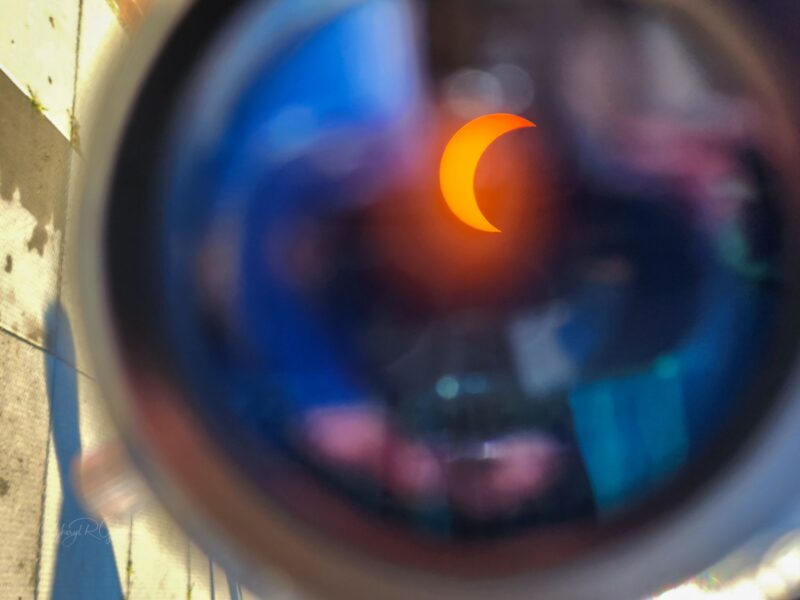

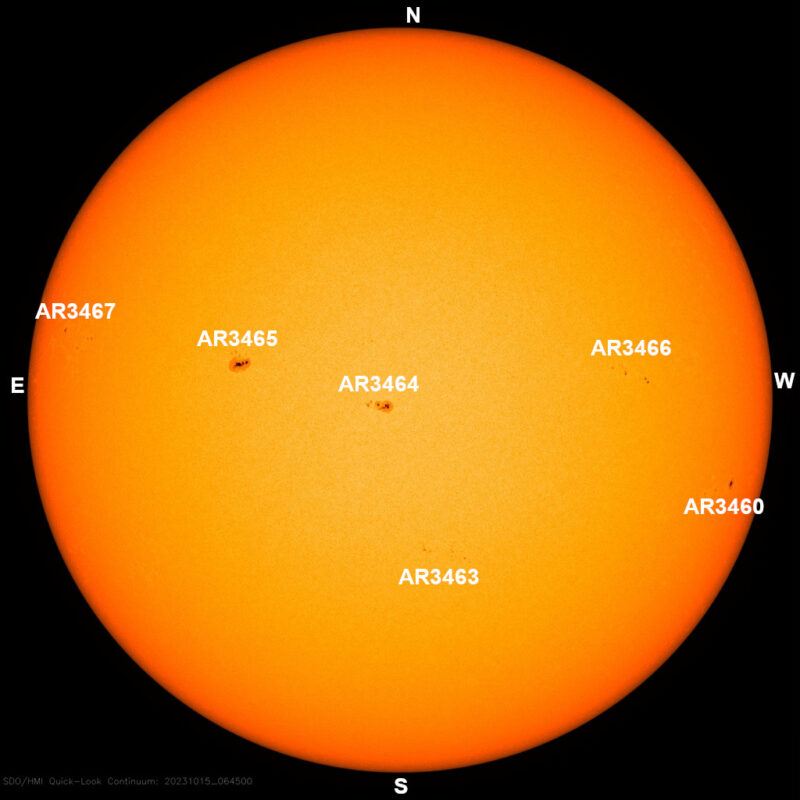
Sun activity for October 14, 2023. Eclipse day! A calm sun for the great event
Today is eclipse day! It seems the sun knows and took day the off to let the annular solar eclipse be the main event. No big activity happened during the past day, and the sun continues at low-level activity with C-class flares. Sunspots on the Earth-viewed side of the sun are either stable or in decay. Only active region AR3460 shows a beta-gamma complexity. The rest show a beta configuration or even an alpha. Read more about seeing sunspots during the eclipse here. All the spotlights are on the main act of the day: the great eclipse of October 14, 2023. Don’t miss it, and watch safely. If weather or location is stopping you from seeing the eclipse, watch EarthSky author and NASA solar physicist C. Alex Young today, live from San Antonio on the Weather Channel starting at 10 am Central (15 UTC)!
Last 24 hours: Sun activity continues at low levels, with only C flares and a low level of flares overall. During the past day (11 UTC yesterday to 11 UTC today), we saw only 6 C flares. The largest was a C9.9 flare, nearly an M, by active region AR3460 on the southwest quadrant. It blasted out at 5:15 UTC on October 14. Honors for the top flare producer of the period goes to an incoming region, as yet unlabeled, currently on the northeast limb (edge). It exploded four flares out of the total. The sun today bears six active labeled regions on its Earth-viewed side.
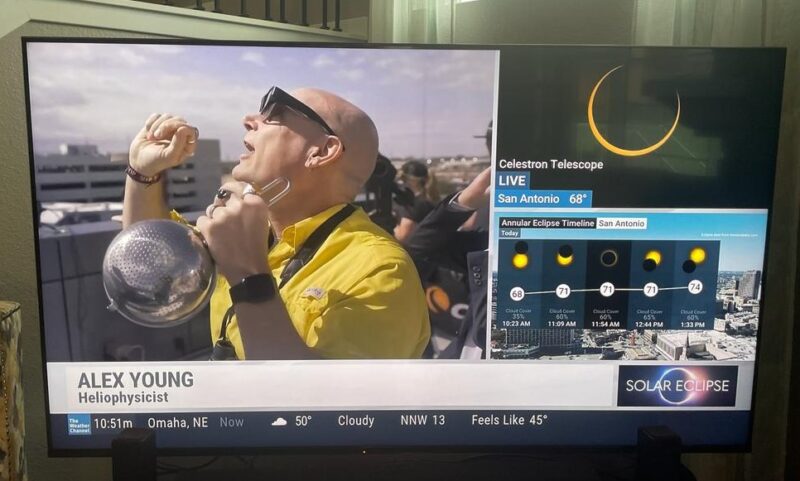
The 2024 lunar calendars are here! Best Christmas gifts in the universe! Check ’em out here.
Sun activity for October 13, 2023. Yesterday’s must-see spectacular prominence
A long filament channel exploded early in the day yesterday (around 12 UTC on October 12, 2023). The blast produced a spectacular prominence, a long rope of solar material and magnetic fields extending from the sun’s visible surface. You can see in the animation below how the exploding filament follows a random path of magnetic structures all around the sun’s northwest quadrant. The blast also produced a slow-moving coronal mass ejection (CME). Specialists are still taking a deep look at it, to determine if there is a component aimed Earth’s way. By the way, don’t miss the October 14 solar eclipse! Here are some resources.
Last 24 hours: Sun activity is low. No M flares over the past day (11 UTC yesterday to 11 UTC today). We did see 16 C flares, though. Honors for the largest flare of the period are shared between sunspots AR34564 and an incoming active region on the northeast, as yet unnumbered. Both blasted a C3 flare, the first at 12:32 UTC on October 12 and the second at 14:38 UTC on October 12. But the region that produced the most flares was, believe it or not, again departing region AR3451 with four flares. This active region seems to depart and depart and never leaves! From the sun’s edge, and beyond, it keeps flaring. AR3460 lost its delta configuration. The rest of the active regions remained stable or in decay. The sun currently has six labeled active regions on its Earth-facing side.
Sun activity for October 12, 2023. M1.1 flare from AR3451 keeps levels moderate
Departing region AR3451 gave us one last hurrah, an M1.1 flare at 4:58 UTC on October 12, 2023. It did not stop there but lead the day in flares. GOES-16 SUVI 304 captured the region’s flash on the northwest limb (edge). In the meantime, an enormous long lasting prominence awaited on the far side for AR3451’s arrival. Just before the M flare, region AR3460 produced an almost M flare, a C9.7. This occurred at 3:47 UTC on October 12, 2023. AR3460 showed some decay and lost its delta magnetic complexity. It did show a beta-gamma-delta magnetic configuration during the day but eventually started to decay. Elsewhere on the sun, as the large coronal hole we have been observing has moved to the southwest limb (edge), what looks like a new coronal hole is forming in the southeast quadrant.
Last 24 hours: Sun activity is moderate with a last minute M1.1 flare from departing region AR3451 at 4:58 UTC on October 12, 2023. The sun produced 14 C flares, one of them by AR3460 was an almost M flare. This C9.7 came just before the M at 3:47 UTC. All this occurred during the past day, between 11 UTC yesterday and 11 UTC today. The M flare caused R1 (minor) radio blackout affected an area over Indonesia. The lead flare producer was departing region AR3451 with eight flares including the M flare. The sun currently has nine labeled active regions on its Earth-facing side. There is a newcomer region, AR3465.
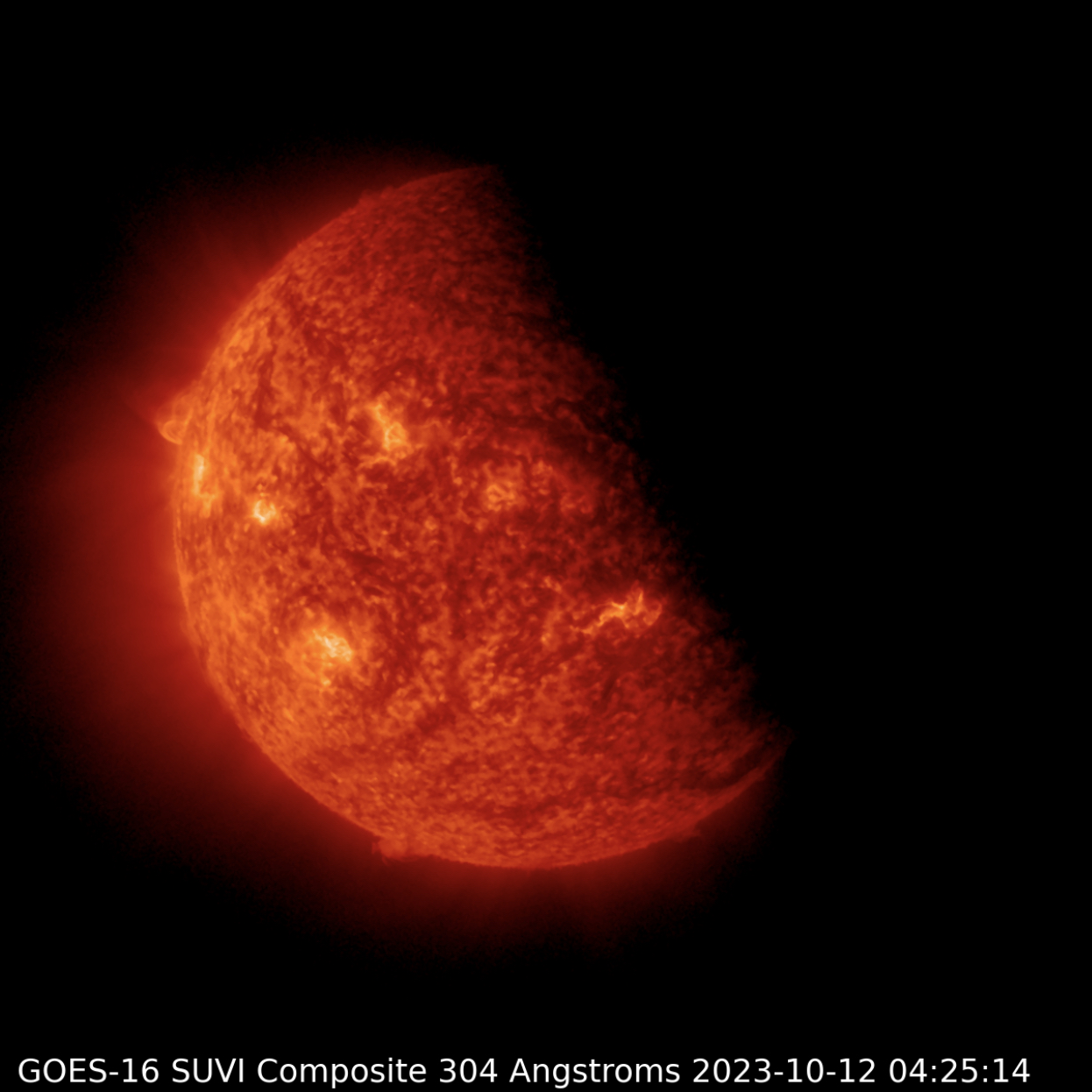
Sun activity for October 11, 2023 is moderate, with an M flare from departing sunspot AR3451
Sun activity remains moderate, thanks to an isolated M2.3 flare from AR3451 at 12:17 UTC on October 10. The sunspot region fired the flare as it departed from view over the western horizon. It seems it was putting on a show for us, as now that it’s leaving it seems to have lost its delta region (a level of magnetic complexity that makes intense flares more likely). Region AR3460, however, has retained its delta region. On the solar south pole, we saw a gorgeous tornado-like prominence at around 2:30 UTC on October 11. Due to its position, the ejecta it hurled into space is not headed towards Earth. Check out the beautiful imagery below. Also, be sure to take a look at the glorious entrance of Mercury into the field of view of the SOHO spacecraft. It was synchronised beautifully with Spica – the brightest star in the constellation Virgo – arriving on the opposite side.
Last 24 hours: Sun activity remains moderate. Between 11 UTC yesterday and 11 UTC today, the sun produced 13 flares: 1 M and 12 Cs. The largest was an M2.3 flare from AR3451 at 12:17 UTC on October 10. The M flare caused an R1 (minor) radio blackout over the Atlantic off the west coast of Africa. The joint-lead flare producers of the past day were AR3451 and AR3464, with four C flares each. AR3464 is a newcomer in the solar neighborhood, having arrived on the southeast limb (edge). The sun currently has eight labeled active regions on its Earth-facing side.
Sun activity for October 10, 2023: Sunspots showing potential
After sunspot AR3451 gave us a C9.2 flare, almost crossing the M flare threshold, AR3452 finished the job. Its M1.2 flare, fired at 2:09 UTC this morning, raised activity to moderate. While AR3451 couldn’t quite get there this time, its beta-delta magnetic configuration means that it still has a good potential to produce M flares, and maybe even an X flare. And it’s not the only sunspot showing promise at the moment. The region we highlighted yesterday, AR3460, continues to evolve and grow, and is also showing signs of a delta region. Meanwhile, the current coronal hole has moved into a geoeffective position, meaning that its fast solar wind will be heading straight towards us. As it buffets Earth, it could cause geomagnetic disturbances and auroral displays. Stay tuned!
Last 24 hours: Sun activity is moderate with 1 M flare. Over the past day (11 UTC yesterday and 11 UTC today) the sun produced 15 flares. The largest event was an M1.6 from AR3452 at 2:09 UTC on October 10. The remaining flares were all C-class. The M flare caused an R1 (minor) radio blackout over Papua New Guinea. The lead flare producer of the past day was sunspot region AR3460. The sun currently has eight labeled active regions, including new region AR3463.
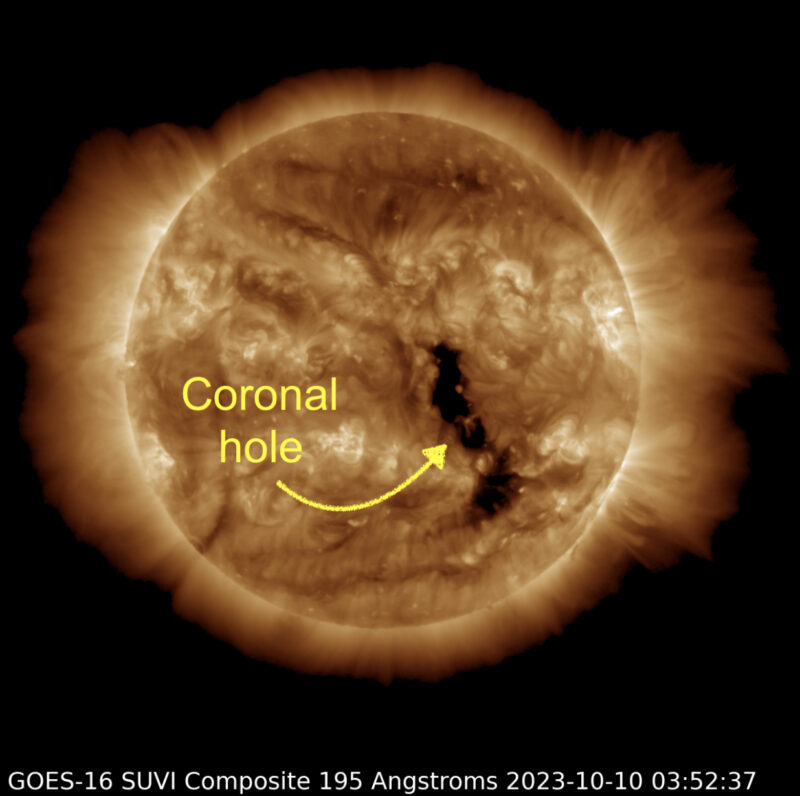
Sun activity for October 9, 2023: A sunspot region starting from nothing
Our little powerhouse region from yesterday – AR3460, which appeared magnetically simple, yet produced an M flare – hasn’t continued its moderate flare production. But now its magnetic complexity has changed from appearing very simple to showing some minor complexity (a beta-gamma configuration). As scientists have noted, magnetic complexity in sunspots is tied to increasing flare activity. So it’s worth watching this region emerge from nothing on the sun’s photosphere, to its current state, using data from the Solar Dynamics Observatory (SDO). Check out our animation. Also notable today is AR3451, which has developed a delta region. Will its magnetic potential turn into some interesting activity? The region is nearly on the western limb (edge) of the sun. So if it is going to do something, today would be a good day for it. But, as always with the sun, we have to wait and see. The anticipation is part of the excitement! Looking at other parts of the sun, we see some good ole prominence action. Nothing too exciting, yet, but there are some stirrings on the western limb (edge) near the equator. In addition, the giant filament across the western solar disk is still there and an eruption waiting to happen. Stay tuned for any exciting updates today and the newest action tomorrow. Meanwhile, for you early risers, just before sunrise, don’t forget to look out for Venus and the moon on the morning of October 10. The star Regulus, in Leo, is also nearby. These early morning dance partners keep getting closer!
Last 24 hours: Sun activity is low, with lots of flares, but only minor flares, 23 C flares during the past day (11 UTC yesterday and 11 UTC today). The largest event was C6.4 from AR3451 at 8:34 UTC on October 9, 2023. The largest flare producer was AR3451 with eight flares. The sun currently has nine labeled active regions.
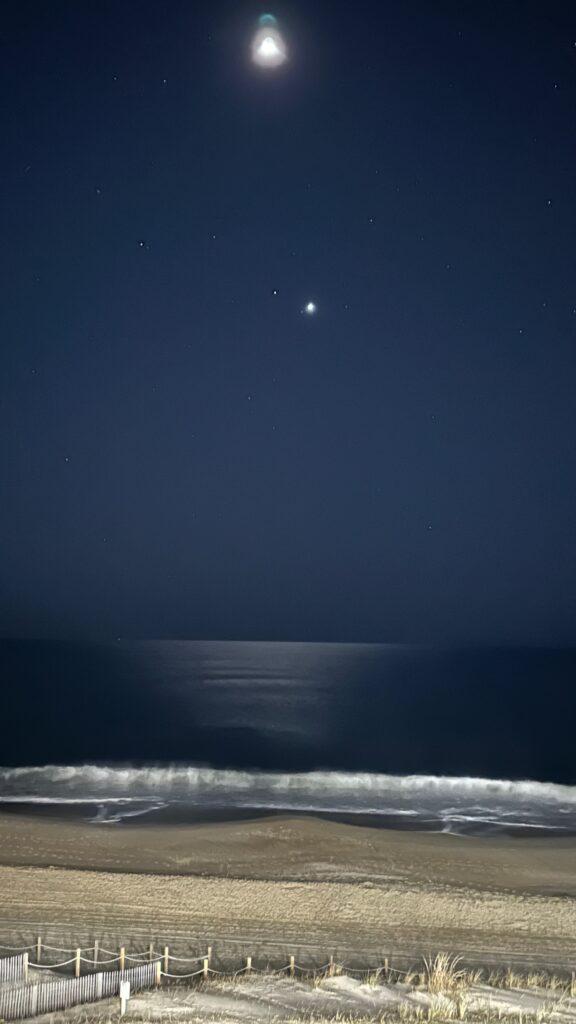
Sun activity for October 8, 2023: The little region that could
We might have considered sun activity low today … if not for a little moxy shown by an otherwise uneventful sunspot region, AR3460. This small and magnetically simple region wouldn’t have been thought of as an M flare producer. But that’s exactly what was produced: an M1.8 flare at 17:57 UTC on October 7. The flare also had a small coronal dimming associated with it. That means a coronal mass ejection (CME) probably released. We do see one in coronagraph imagery that is probably from this event. Initial measurements indicate this does not have an Earth-directed component. Maybe all this excitement from the region means it could grow and have more bang for the buck. We will have to wait and see. Elsewhere, we still have a nice coronal hole near the central meridian and the giant filament stretching from near the north pole down to just over the equator. We call this a transequitorial filament. Stay tuned for more sun fun! That includes the upcoming annular – or “ring of fire” – solar eclipse. It’s due to cross the U.S. one week from today on October 14, 2023. Get ready for the eclipse by testing your safe solar viewing method – your eclipse glasses or solar binoculars or indirect viewing system – on the sun this week. You might see some sunspots move from day to day across the sun’s visible face. Isn’t the sun a cool star? We think so ?.
Last 24 hours: Sun activity is moderate. This is due to a lone M1.8 flare from AR3460. This flare produced an R1 (minor) radio blackout over the Pacific Ocean and South America. The remaining 19 flares during the past day between 11 UTC yesterday and 11 UTC today, were C flares. The lead flare producers were AR3451 and AR3460 with six and five flares respectively. Sunspot region AR3451 kept its beta-gamma magnetic complexities during the period. The more interesting item is that AR3460, which produced the M1.8 flare, only has a very simple alpha configuration. The sun currently has nine labeled active regions.
Sun activity for October 7, 2023: A fiery new active region is coming
An incoming active region on the sun’s northeast limb (edge) has introduced itself with several C flares, including an eruptive C4.2 flare. During the past day we saw the formation of a coronal hole on the southeast quadrant. The transequatorial filament we observed in past days persists and now extends to cross the northwest quadrant and reach into the southwest. Stay with us for more sun news. By the way, surely you’ve heard of the upcoming annular – or “ring of fire” – solar eclipse? It’s due to cross the U.S. one week from today on October 14, 2023? Get ready for the eclipse by testing your safe solar viewing method – your eclipse glasses or solar binoculars or indirect viewing system – on the sun this week. You might see some sunspots move from day to day across the sun’s visible face!
Last 24 hours: Sun activity is low. There were only 11 C class flares during the past day between 11 UTC yesterday and 11 UTC today. The largest event was a C4.2 flare that occurred at 18:17 UTC, October 6, from the unnumbered active region now rotating into view on the sun’s northeast limb (edge). This region was the lead flare producer with 5 flares of the 11 flares. Sunspot regions AR3451 and AR3452 kept their beta-gamma magnetic complexities during the period. No other active region shows this level of complexity. The sun currently has eight labeled active regions.
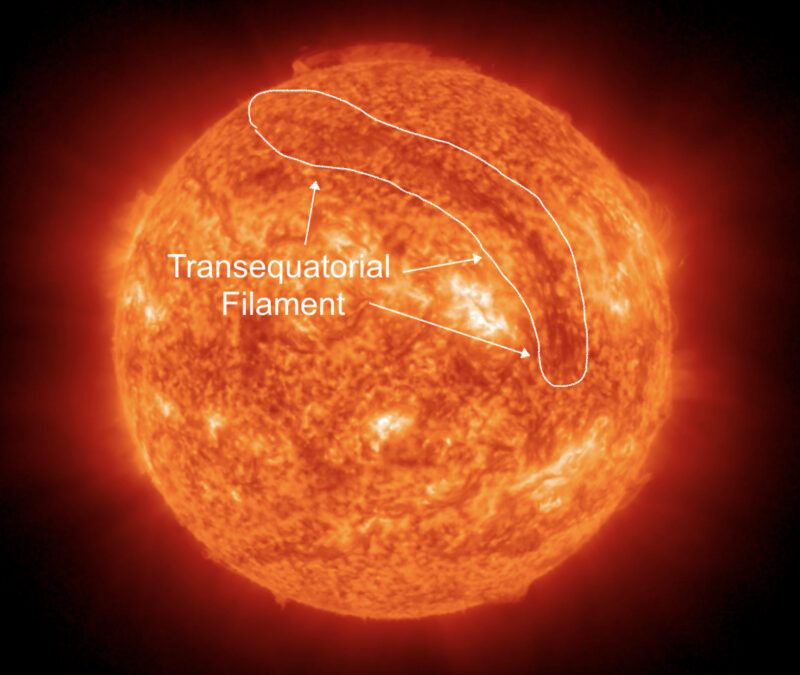
Sun activity for October 6, 2023: Huge prominence, auroras on the way
Not to be outdone by yesterday’s beautiful eruption in the northeast, the northwest limb (edge) has struck back with a huge prominence. This has continued the ping-pong back and forth of spectacular activity from beyond the northwest and northeast horizons over the last three days. With low activity continuing on the Earth-viewed solar disk, it seems that the party is on the other side of the sun! A party will soon be arriving at Earth, though – get ready for auroral displays tomorrow! A G1 (minor) geomagnetic storm is forecast with the arrival of a coronal mass ejection (CME) fired from the sun on October 2. If this CME arrives early, the show may start tonight. Aurora chasers in northern latitudes, get ready!
Last 24 hours: Sun activity is low, with only 9 C flares produced between 11 UTC yesterday and 11 UTC today. The largest flare was a C4.7 at 19:13 UTC from sunspot region AR3451 on October 5. This region was the lead flare producer of the past day, producing 7 flares of the 9. We saw some activity in the southeast quadrant, where coronal mass ejections (CMEs) were hurled into space by an erupting filament. Sunspot regions AR3451 and AR3452 recovered their beta-gamma magnetic complexities. The rest of the active regions on the Earth-facing side of our sun show simple alpha or beta configurations. The sun currently has ten labeled active regions, including two newcomers: AR3458 and AR3459.

Sun activity for October 5, 2023: Northeastern prominence erupts into space
The prominence we pointed out yesterday on the northeast limb (edge) has erupted into space. Its slow, steady rise and release was captured by the NOAA GOES-16 spacecraft (see the animation above) and by the Solar Dynamics Observatory (SDO). Although this event occurred just over the solar horizon, specialists have found that fast-moving solar material released in the eruption may catch up with a previously fired coronal mass ejection (CME) and join it on its way towards Earth. However, we are awaiting confirmation on this. There are in fact two CMEs currently on the way to us, released on October 2 and 3, and there is a chance they’ll give Earth a glancing blow between late tomorrow and October 7.
Last 24 hours: Sun activity is low, with just 4 C flares produced between 11 UTC yesterday and 11 UTC today. The largest was a C3.8 from sunspot region AR3451 at 6:51 UTC, October 5. None of the current sunspot regions are showing any magnetic complexity at this time. The sun currently has eight labeled active regions on its Earth-facing side.
Sun activity for October 4, 2023: Huge, beautiful prominence in the northwest
An amazing prominence adorned the sun’s northwest limb (edge) earlier today. The explosion of solar material started at around 0:28 UTC on October 4. It occurred beyond the solar horizon, so it may have come from an active region that just rotated out of view. Given its position, the coronal mass ejection (CME) is most likely not coming our way. We also saw fiery action on the northeast limb, where a long-lasting prominence danced all through this morning. At the time of this writing (11 UTC on October 4) it has started to break into what looks like a big eruption. We’ll let you know what transpires!
Last 24 hours: Sun activity is back to low, with the production of only C flares between 11 UTC yesterday and 11 UTC today. Of the 18 total flares, the largest was a C3.6 from sunspot region AR3450 at 17:03 UTC, October 3. This region is still showing a fairly complex beta-gamma configuration (the higher the complexity, the higher the chance for large flares) and is today’s lead producer with nine flares. The sun currently has seven labeled active regions on its Earth-facing side after yesterday’s newcomer AR3455 vanished completely.

Sun activity for October 3, 2023: An M1.9 flare raises activity to moderate
Sun activity is back to moderate with the production of an M1.9 flare by AR3455. It was an eruptive flare, which means it coincided with an eruption of solar material. We also saw an exploding filament in the southeast, which hurled a faint coronal mass ejection into space. Due to the location of the filament and the orientation of the ejecta, this could be on its way to Earth. We’ll let you know when we get confirmation from the specialists.
Last 24 hours: Sun activity is moderate. The sun produced a total of thirteen flares over the past day (11 UTC yesterday to 11 UTC today). The largest was an eruptive M1.9 flare from sunspot group AR3455 at 12:46 UTC, October 2. The flare produced an R1 (minor) radio blackout over the South Pacific Ocean off the southwest coast of Africa. AR3451 lost its delta region, reducing its likelihood of large flares, while AR3450 is showing a fairly complex beta-gamma configuration. The long filament we saw yesterday on the northeast quadrant has now extended into the solar southern hemisphere, becoming a transequatorial filament. The sun currently has eight labeled active regions on its Earth-facing side, including newcomer AR3455.
Sun activity for October 2, 2023: A quieter day on our star
After 24 hours of flashing flares the day before, the sun over the past day has exhibited low activity. We’ve seen only 14 flares in the last 24 hours, and all of them were C-class. That’s a step down from the previous day’s showing! Despite the decrease in sun activity, our star has sprouted several more sunspot regions with AR3452, AR3453, and AR3454. None of these regions have developed any magnetic complexity, yet. Now it’s another waiting game to see what surprises the sun may bring. Stay tuned!
Last 24 hours: Sun activity is low with only 14 C flares over the past day (11 UTC yesterday to 11 UTC today). The largest was a C4.5 flare from sunspot group AR3449 at 23 UTC on October 2. AR3451 kept its delta region, which provides indication of its continued potential for larger flares such as M or even X-class events. The sun currently has eight labeled active regions on its Earth-facing side.
Sun activity for October 1, 2023: A flurry of flares from AR3451 and friends
The newcomer sunspot region we spoke about yesterday has now rotated fully into view and has received a label of AR3451. It’s been having fun with flares over the past day, releasing two M flares and 12 C flares! Its near companions – sunspot regions AR3445 and AR3450 – joined in the festivities, producing the remainder of the C flares over the past 24 hours. Looks like Solar Cycle 25 – whose maximum is expected in the mid-2020s – is on schedule. The magnetic complexity of AR3450 and AR3451 indicate the potential for additional moderate-to-high flaring. Now – as always – we wait. Will they meet expectations? Meanwhile, the two coronal holes on the sun’s disk might bring a small bit of auroral action here at Earth, from their high speed solar wind. Stay tuned!
Last 24 hours: Sun activity rose to moderate levels, with two M flares over the past day (11 UTC yesterday to 11 UTC today). The largest was an M2.5 flare from sunspot group AR3451 at 1:10 UTC on October 1. The region also released an M1.1 at 16:16 UTC on September 30. Both events caused radio blackouts over East Asia/ Australia and the Americas, respectively. A total of 24 flares were produced in the past day, with 13 of the flares including the two M flares coming from the newcomer, AR3451. AR3450 and AR3451 have increased in magnetic complexity. AR3450 has a beta-gamma configuration and AR3451 has developed an delta region. This means there is a lot of potential for more flares with a strong potential for more M flares and maybe an X. The sun currently has seven labeled active regions on its Earth-facing side.











